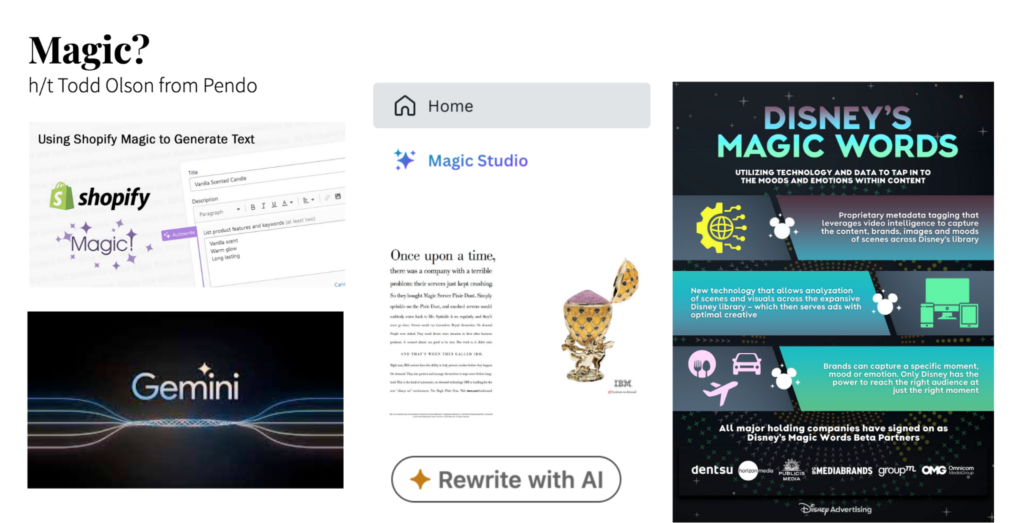Artificial intelligence offers immense opportunities to enhance product experiences and operational efficiencies. However, integrating AI into product design requires rethinking design principles.
Traditional design principles have served well for decades as we adapted to mobile, social, and more global products. AI, however, introduces complexities that these principles are not fully equipped to handle. AI can process, learn from interactions, and make predictions; it evolves in a different way and has more risks to society, demanding a more dynamic and responsive design approach.
The following 10 principles provide a framework for how we should think about both incorporating AI into existing products and creating new products that are AI-enabled.
Useful
With any new technology, the risk is that we focus on what can be done instead of what’s needed. Products should primarily be useful, meeting user needs effectively and enabling them to achieve their goals efficiently. Stay focused on problems that are needs for your customer. Here are some examples:
- Manufacturers struggle to accurately estimate how much it costs to move goods across an ocean so they choose Xeneta’s capability to analyze data and give real-time estimates.
- If you are learning a new language, you may have a hard time in common social scenarios like asking for directions, so you choose ELSA, an English language speech assistant that can give you feedback on your speech.
- If you are a services company worried about customer retention, Knownwell gives you a real-time view of client health based on interactions your team has with the clients
These examples show how companies are tapping into AI’s ability to deal with large data sets, make predictions, and offer guidance without the user having to do a lot of work to set everything up.
Supportive
Remember the helpful nudge from Gmail when you forgot to attach a file mentioned in your email? Google Calendar reminding you that it was time to leave for your meeting across town? These are examples of how a product can provide guidance and reminders, prevent errors, and make it easy to correct them.
One of our challenges is adopting new AI capabilities when customers are not quite sure what they can do and how to use them. We need to provide some scaffolding to guide them along by suggesting what questions they can ask or what things the product can do. Designers have done this for a long time by using visual metaphors like a physical file folder, a camera, or a bookshelf to help people get comfortable with a new interface. Then, we can remove the scaffolding once they are comfortable.
This is likely why companies are using the imagery and language of magic to promote their AI capabilities. I have to give credit to Todd Olson, CEO of Pendo for this observation.
Personal
AI can make every interaction feel uniquely tailored to the user, their device and their specific situation and surroundings, even their emotional state can be adjusted to. Reclaim.ai helps employees and teams manage their calendars by building in working hours, buffer time, habits and heads down work. Spotify’s Daylist seems to get my vibe right and knows that as many times as I’ve played “It’s Raining Tacos” in the car, it’s not my jam. Three playlists are generated each day with unique and captivating titles like “Midwest Emo Flannel Tuesday Early Morning.”
They remove the daily things that waste time and cause frustration at a company. The power of AI to deeply personalize content also raises concerns regarding manipulation, bias, and privacy, creating more fragmentation and disconnection in our communities.
Understandable
We mostly hear about explainable AI. This is the ability of the system to express why it made the decision, recommendation, or prediction. Just because a data scientist or machine learning expert can explain it doesn’t mean that users understand the explanation. My preference is that we focus more on the person receiving the explanation than the one giving it.
Being understandable will drive adoption within companies and with customers. Professionals are unlikely to take a recommendation to a client if they can’t explain the reasoning. It also supports risk and compliance, who are concerned about things like fair housing and fair credit.
Designers have an important role to play in shaping how the explanation is delivered to clients through simple text, visualizations, confidence scores or other methods.
Proactive
New tools can anticipate user needs and act proactively. This is a significant advantage in enhancing user experience. By leading with insights, AI can deliver information before users even realize they need it. For example, Knownwell exemplifies this proactive approach by alerting users to important information at the right time and through their preferred communication channels, such as text or email. This intuitive functionality ensures that users are always well-informed, facilitating smoother and more efficient interactions.
Accessible
AI products should be accessible to everyone, regardless of their abilities or backgrounds. While AI has the potential to greatly enhance accessibility, researchers have found it’s inconsistent and has abelist tendencies, according to University of Washington researchers. Some AI tools have struggled with consistent application of accessibility rules, highlighting the need for ongoing improvements in this area.
Inclusive
It’s important for AI products to proactively detect and mitigate unfair biases in data and algorithms, align with ethical principles and societal values, ensure responsible deployment practices, and prevent discrimination against any user groups. The work of doctors Joy Buolamwini and Timnit Gebru showed how most commercial facial recognition systems struggled to classify the gender of women with darker skin and led to IBM and Microsoft stopping face-based gender classification.
Trustworthy
Globally, trust in AI companies has dropped 8% in five years and 15% in the United States. This is part of a larger erosion of trust in the tech industry according to Edelman.
Trust comes from being transparent, predictable, and empathetic. Be transparent about the capabilities of the AI and how much trust the user should put into the results. Include safeguards, fallback mechanisms, and clear boundaries to ensure reliable, safe, and ethical operation, even in unexpected situations or adversarial conditions. Logging observations and auditing decisions will create additional trust on highly important systems for identity, credit and health.
Anthropic, founded by employees who left Open AI over ethical concerns, uses a technique called constitutional AI to align human values to their training methods. While Anthrophic itself says it’s not perfect, it’s interesting to see how they are drawing on ideas from the UN Declaration of Human Rights and other sources to inform what they are doing.
Private and Secure
AI-enabled products should protect user data with robust security measures, giving users control over their data collection and usage while adhering to privacy regulations and best practices. Users should have control and choice over their data collection and usage practices.
Evolving
In the past, improvements required product teams to ship new code. AI products can improve without the team’s intervention. The goal is to create a virtuous cycle that improves the models. Andrew Ng describes this in the AI Transformation playbook. The more users you have, the more data you have, and the better the product gets as the models learn and retrain.
Blue River Technology started as a project in a Stanford lab where students used cameras to take pictures of weeds in farmer’s fields. As the company grew, they got more and more examples, and eventually they were able to detect which weeds were in the farmer’s fields and how little pesticide to use. They were able to reduce pesticide use by 90%, reduce pesticide resistance, and were acquired by John Deere for $305 million.
What’s next
- Review Existing Principles: Assess your current design principles to identify areas where AI can enhance or necessitate changes.
- Engage with Customers: Dialogue with your customers to discover how AI can better serve their needs or help you reach a broader audience.
- Collaborative Workshops: Conduct workshops with team members from sales, customer support, product, design, and marketing to create AI-focused principles tailored to your company’s needs.
As we integrate AI into our products, adopting these updated design principles will ensure that we not only keep pace with technological advancements but also deliver user-centric, ethical, and impactful AI solutions.
About the Author
Jessica Hall is a Knownwell AI Advisory Board member and a leading voice on how UX will change in the age of AI. She has spent more than a decade on the cutting edge of innovation, design, and product leadership, a combination that gives her a unique perspective on how AI experiences can impact business growth. She is the VP of Design for CoStar, a publicly-traded global leader in the digital transformation of the $300+ trillion real estate industry, and a sought-after speaker on topics including product leadership in the AI era.



